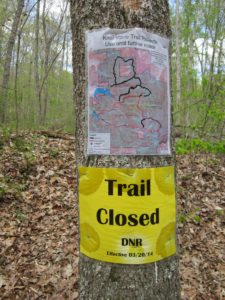By Jason Flickner & Jeff Stant, IFA Executive Director
At the encouragement of the Indiana Forest Alliance, dozens — even hundreds — of citizens have been contacting Governor Mike Pence to ask him to limit logging on our state forests, and to set aside 13 State Wild Areas. When people make contact, they get a form letter from Sam Hyer, Pence’s liaison for the Department of Natural Resources.
The letter explains that “harvesting is not new” and “DNR Forestry staff includes 30 degreed foresters, a wildlife biologist, an archaeologist, and two others with natural resources degrees” and “DNR Forestry meets national and international standards for sustainable management of our State Forests.”
IFA has a rebuttal, to be sure (below). We encourage you to continue to engage Governor Pence on this crucial issue, in your own words.
 Dear Governor Pence,
Dear Governor Pence,
Thank you for your response to my letter about logging on Indiana’s state forests. You state in your letter, “The State Forest system is audited annually by two independent audit firms and has been certified for nine consecutive years.” The fact is, as part of this sustainable logging certification, the Division of Forestry (DOF) has promised since 2011–in response to a corrective action requirement in its Forest Stewardship Council audits–to set aside 10% of the state forests in old forest conditions and delineate these areas. The DOF has never taken this step. Please provide me and the public with a map clearly outlining these areas in the state forests that are being managed as old forest. Alternatively, please provide the state forest name, compartment, and tract numbers that fulfill this FSC certification requirement.
In addition, you assert that under the 2015-2019 Plan harvest levels, the forests will still continue to grow at a rate greater than the harvests. Thus, by the end of the Plan period there will still be a healthy, growing forest. I understand the forest will continue to grow, but am not gullible enough to believe that a Plan that proposes to log through 95 percent of our state forests in 20 years replacing all of the multiple-aged older forest stands with early successional vegetation and much younger trees throughout the state forests is beneficial for our hardwood forest ecosystem.
Furthermore, I strongly disagree with your assertion that a forest that has been logged and intruded upon by heavy machinery, with most slopes scarred to bare dirt and rock by skidders and skidder trails leading to a network of new graveled logging roads, is as healthy as a forest ecosystem left alone to fully mature and turn over through natural succession. Extensive scientific research has documented that any type of logging intrusion in our hardwood forests, whether for single-tree selection or clear cuts, causes long-term disturbances to interior forest habitat that many sensitive, rare, threatened and endangered species require. Research also documents the extensive introduction and dispersion of nonnative invasive plants into forest habitats that is occurring from logging and the construction of logging roads in the state forests.
Finally, the extraction of timber from our state forests repeatedly damages recreation opportunities, which are supposed to be an integral component of the Division of Forestry’s mission to practice multiple-use management of the public’s land. The state forests provide dispersed recreation opportunities related to the enjoyment of wilderness that are not provided by other state public lands. Closures of primitive camping and hunting sites, and closures and rerouting of long-distance hiking, mountain biking, and bridle trails impact the ability of Indiana’s state forests to bring recreation dollars into local communities. The state has never conducted a meaningful cost analysis of commercial timber harvests on the state forests or evaluated lost and unrealized revenue generation potential from recreation resources damaged by logging that might otherwise bring dollars to businesses in surrounding rural, and often economically depressed, communities.
Indiana does not own state corn fields or state soybean fields. Likewise our precious limited state forests (which comprise only 5 percent of Indiana’s forests) should not be managed as though they are tree farms nor should the primary value of the trees in them, our trees, be viewed simply in terms of being a crop. Leaving most of the state forests standing and undisturbed by logging while promoting their unique recreational qualities is a more economically durable and ecologically sustainable application of mixed-use management that Hoosiers have a right to expect in their state forests.
Instead, your budget-driven commercial timber sale programon the state forests competes with private landowners practicing responsible forestry and selling their timber for fair market prices. In the process, you are seriously degrading 95% of Indiana?s state forest acreage, and will soon deprive the next five generations of Hoosiers of the majestic forests that we enjoy in our state forests today.
Thank you for your response but please understand that you are not addressing my initial and sustained concerns.
